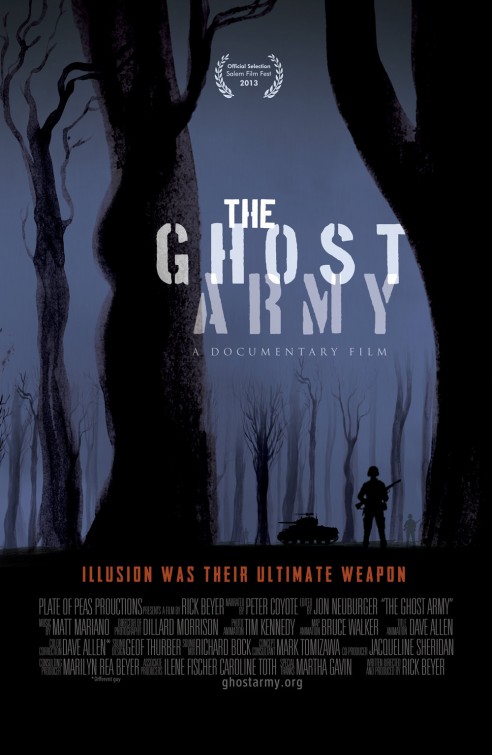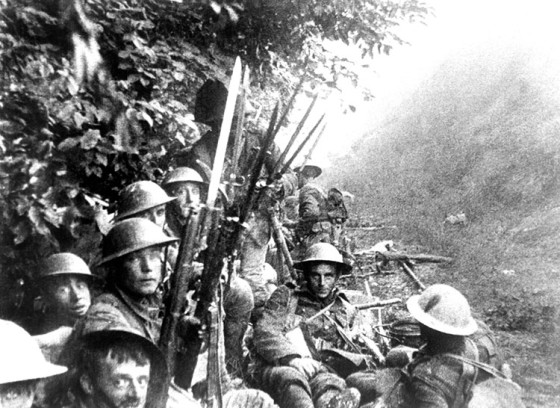
On April 1, we told you about some of the most famous wartime deceptions in history from the legendary Trojan horse to dummy cannons called Quaker guns. What we didn’t tell you about was the U.S. Army’s 23rd Special Headquarters Troops, known affectionately as the “Ghost Army”.
This top-secret unit, which served in Europe from the Normandy Invasion right up to the war’s end, didn’t actually fight — its job was to confound, deceive and fool the enemy. And according to most accounts it was mission accomplished. Using everything from half-track-mounted loudspeakers and phoney radio chatter to dummy vehicles and all manner of smoke and mirrors, the Ghost Army was a curious mix of a sort of Army Rangers mixed with Penn & Teller. Recruited from Madison Avenue ad agencies, the Broadway stage and Hollywood back lots, the rank and file Ghosts were visual artists, combat engineers and creative types who excelled at special effects, illusion and set design. While the unit had fewer than 1,100 men, it could easily disguise itself as a 30,000-strong army, complete with armour and artillery, motor pools, sprawling camps, divisional headquarters, and even air support.

Ghost Army in the Field
Some of the 23rd’s more successful scams included conning a much larger Wehrmacht unit in the port city of Brest into believing it was surrounded by an entire Allied army, and later in the war staging what appeared to be a massive Allied river assault of the Rhine to draw defenders away from actually planned crossing points. In one operation, it used lanterns and lights to simulate an Allied harbour facility in the days following the D-Day landings to draw enemy fire away from the real beachhead. In other missions it infiltrated the frontlines to blare battle sound effects on mobile loudspeakers. The combat noises, which could be heard for 15 miles, distracted and confused the enemy, often forcing them redeploy to meet what it thought was an Allied onslaught. The Ghost Army was also known to flood the airwaves with bogus Morse code signals, while sending its soldiers into civilian cafes and coffee shops to drop all sorts of misleading rumours, gossip and misinformation.
The British Magic Gang
The Ghost Army, which was organized in the months leading up to the D-Day landings, took its cue from a British outfit in North Africa called the A Force, better known as the Magic Gang. Headed by an English film-maker named Geoffrey Barkas, the outfit was famous for hiding British planes and tanks in the open desert, creating dummy rail yards and port facilities for German bombers to attack while concealing the real ones and even fooling Rommel into believing that the British were going to assault the Afrika Corps far south of the actual objective of El Alamein. One of that unit’s better-known members was Jasper Maskelyne, a noted magician turned military camofleur who was famous for a number of large-scale illusions that confused German and Italian forces.

Ghost Army: The Movie
For decades, the Ghost Army’s most convincing stunts were kept under wraps. Even its very existence was classified. It wasn’t until 1996 that much of what we know about the 23rd Special Headquarters Troops was finally made public.
However this secretive outfit is about to get a lot more famous. The American public broadcaster, PBS, will air a special one-hour documentary about the unit in May. Simply entitled The Ghost Army, the film will also be screened at the GI Film Festival in Arlington, Virginia on May 10, the Washington D.C. Press Club on May 13 and the National World War Two Museum in New Orleans on May 15. It will air on most PBS stations on May 21.
Check out the official Ghost Army trailer here or visit the PBS website devoted to the documentary here.











It’s awesome in support of me to have a web site, which is helpful for my know-how. thanks admin